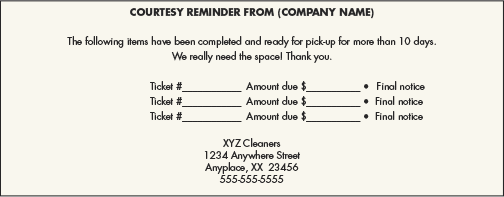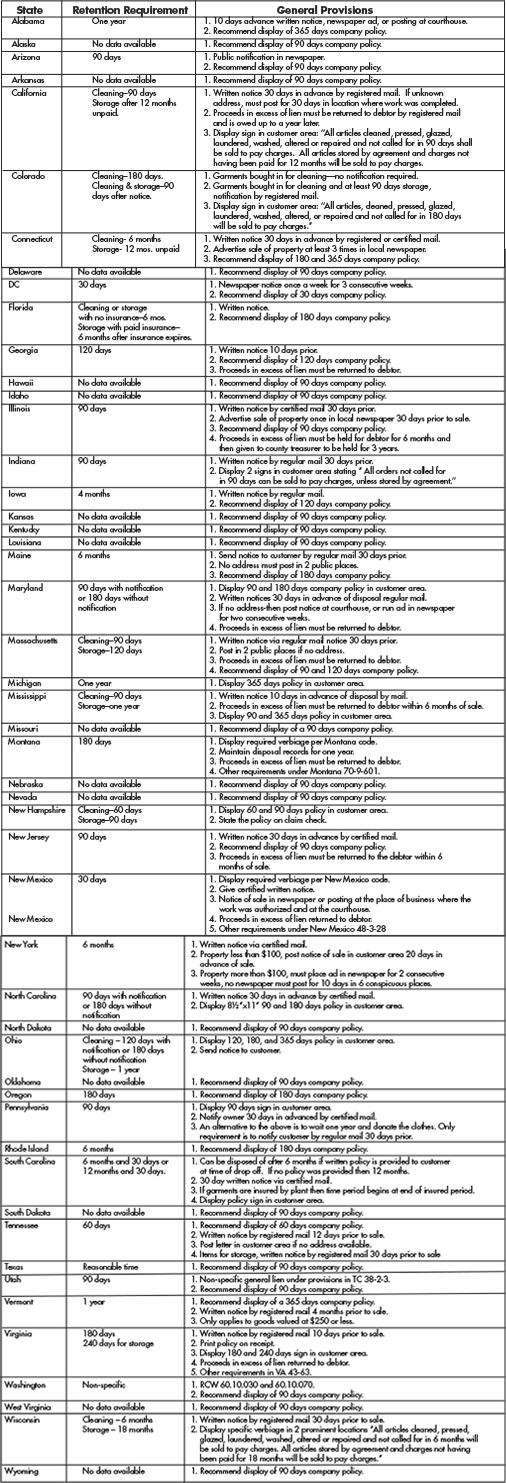
Customers that do not pick up their orders in a timely manner create money and space problems. Business studies confirm the longer a bill goes unpaid, the less likely it will be paid. The longer inventory remains unclaimed, the less likely it will be picked up.
Keeping a close eye on inventory buildup is always important. Putting a simple plan in place that prohibits inventory buildup can solve the problem and prevent it from happening again.
A PLAN
First, make certain that accurate customer contact information on each order is obtained. Typically, this means obtaining a mailing address and telephone number. If you can create a customer profile, getting an e-mail address* can be very useful. Second, an ongoing system of customer contact has to be put in place and maintained. It used to be normal practice that customers be contacted if their orders were not picked up within thirty days, but that doesn’t work anymore. It’s too long to wait. Ten days needs to be the outside cutoff date for reminding customers they have orders to pickup.
Require a SUBSTANTIAL DEPOSIT or PAYMENT IN FULL before any work begins on any specialty, high-end, alteration or repair, leather, drapery, bedspread cleaning, or shoe repair.
*E-mail and automated calling can also be especially useful to contact inactive customers, remind customers of route pickup and delivery, and even offer special unadvertised sales.
GETTING STARTED
To get started, contact every customer that has orders that have been ready for pickup for ten days or longer. Calling, e-mailing, or mailing a postcard-sized reminder will provide a gentle nudge to a customer that is helpful to your business and appreciated by your customer. Doing this will quickly produce a boost to sales because customers not only stop by to pick up completed orders, but may drop off a bundle they’ve been meaning to bring in.
A mailed courtesy reminder is generally more effective and cost-efficient than employee time directed to making individual telephone calls. It’s a long and tedious job that somehow never quite gets completed. No one home, answering devices that are full, or speaking with someone that never delivers the message are frequently the result of individual telephone contact efforts. Even if a customer moves, mail seems to catch up with them. Automated telephone calling services are also cost effective.
After the initial push to get aging inventory out, assign as a daily job function a requirement that two letters of the alphabet, or any filing system or electronic inventory control, be checked for orders that have been ready for pickup for ten days or longer. Don’t neglect calling or sending reminders about folded shirt orders and bigger ticket household items. If you are still doing notification manually, this will make the job more manageable.
If you have the capability to e-mail or automatically telephone or text message your customer immediately when an order is ready for pick-up – all the better. It’s certainly a WOW factor that will help cement a customer relationship.
*There are modestly priced services available for contacting larger inventory numbers when supplied electronically. Automated telephone calling continues until a message is delivered.
One big caveat. Double check that the aging order is indeed in inventory.

We suggest that the above copy be printed 4 up on 8 1/2″ x 11″ card stock. Postcard postage is required.
If you have multiple locations, you may wish to consider copy that identifies the address of the store where the items are located. This is completed in this manner:
Your order may be called for at the following location
XYZ Cleaners XYZ Cleaners
1234 Anywhere Street 1234 Anywhere Street
Anyplace, XX 23456 Anyplace, XX 23456
555-555-5555 555-555-5555
DISPOSAL OF UNCLAIMED ORDERS
When you’ve exhausted every effort and still cannot get your customer to retrieve their order, you are left with no choice be to proceed to official and final notification and perhaps sale of the items.
Although requirements for disposal of unclaimed property vary widely in the United States, the accompanying chart provides some key elements regarding retention and disposal.

This article is from DLI’s Mgmt18.

